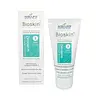What's inside
What's inside
 Key Ingredients
Key Ingredients

 Benefits
Benefits

 Concerns
Concerns

 Ingredients Side-by-side
Ingredients Side-by-side

Water
Skin ConditioningPPG-15 Stearyl Ether
EmollientPropylene Glycol
HumectantSteareth-2
EmulsifyingCetearyl Alcohol
EmollientStearic Acid
CleansingSteareth-21
CleansingDimethicone
EmollientSalicylic Acid
MaskingPotassium Azeloyl Diglycinate
Skin ConditioningSqualane
EmollientCucurbita Pepo Seed Oil
EmollientRosmarinus Officinalis Leaf Oil
MaskingSalvia Sclarea Oil
MaskingChamomilla Recutita Flower Oil
MaskingPanthenol
Skin ConditioningMentha Piperita Oil
MaskingSilica
AbrasiveLauric Acid
CleansingMyristic Acid
CleansingOleic Acid
EmollientPoloxamer 407
EmulsifyingXanthan Gum
EmulsifyingCaprylyl Glycol
EmollientPhenoxyethanol
PreservativeEthylhexylglycerin
Skin ConditioningTriethanolamine
BufferingWater, PPG-15 Stearyl Ether, Propylene Glycol, Steareth-2, Cetearyl Alcohol, Stearic Acid, Steareth-21, Dimethicone, Salicylic Acid, Potassium Azeloyl Diglycinate, Squalane, Cucurbita Pepo Seed Oil, Rosmarinus Officinalis Leaf Oil, Salvia Sclarea Oil, Chamomilla Recutita Flower Oil, Panthenol, Mentha Piperita Oil, Silica, Lauric Acid, Myristic Acid, Oleic Acid, Poloxamer 407, Xanthan Gum, Caprylyl Glycol, Phenoxyethanol, Ethylhexylglycerin, Triethanolamine
Water
Skin ConditioningGlycerin
HumectantUrea
BufferingLinum Usitatissimum Seed Oil
PerfumingCetearyl Alcohol
EmollientOlea Europaea Fruit Oil
MaskingZeolite
AbsorbentCetearyl Glucoside
EmulsifyingBorago Officinalis Leaf Extract
Skin ConditioningRicinus Communis Seed Oil
MaskingSimmondsia Chinensis Seed Oil
EmollientPhenoxyethanol
PreservativeSodium Cetearyl Sulfate
CleansingEthylhexylglycerin
Skin ConditioningCaprylyl Glycol
EmollientCymbopogon Martini Oil
MaskingLavandula Angustifolia Oil
MaskingPelargonium Graveolens Oil
MaskingRosa Damascena Flower Water
MaskingCitronellol
PerfumingGeraniol
PerfumingPhenethyl Alcohol
MaskingLinalool
PerfumingWater, Glycerin, Urea, Linum Usitatissimum Seed Oil, Cetearyl Alcohol, Olea Europaea Fruit Oil, Zeolite, Cetearyl Glucoside, Borago Officinalis Leaf Extract, Ricinus Communis Seed Oil, Simmondsia Chinensis Seed Oil, Phenoxyethanol, Sodium Cetearyl Sulfate, Ethylhexylglycerin, Caprylyl Glycol, Cymbopogon Martini Oil, Lavandula Angustifolia Oil, Pelargonium Graveolens Oil, Rosa Damascena Flower Water, Citronellol, Geraniol, Phenethyl Alcohol, Linalool
Ingredients Explained
These ingredients are found in both products.
Ingredients higher up in an ingredient list are typically present in a larger amount.
Caprylyl Glycol is a humectant and emollient, meaning it attracts and preserves moisture.
It is a common ingredient in many products, especially those designed to hydrate skin. The primary benefits are retaining moisture, skin softening, and promoting a healthy skin barrier.
Though Caprylyl Glycol is an alcohol derived from fatty acids, it is not the kind that can dry out skin.
This ingredient is also used as a preservative to extend the life of products. It has slight antimicrobial properties.
Learn more about Caprylyl GlycolCetearyl alcohol is a mixture of two fatty alcohols: cetyl alcohol and stearyl alcohol. It is mainly used as an emulsifier. Emulsifiers help prevent the separation of oils and products. Due to its composition, it can also be used to thicken a product or help create foam.
Cetearyl alcohol is an emollient. Emollients help soothe and hydrate the skin by trapping moisture.
Studies show Cetearyl alcohol is non-toxic and non-irritating. The FDA allows products labeled "alcohol-free" to have fatty alcohols.
This ingredient is usually derived from plant oils such as palm, vegetable, or coconut oils. There is debate on whether this ingredient will cause acne.
Due to the fatty acid base, this ingredient may not be Malassezia folliculitis safe.
Learn more about Cetearyl AlcoholEthylhexylglycerin (we can't pronounce this either) is commonly used as a preservative and skin softener. It is derived from glyceryl.
You might see Ethylhexylglycerin often paired with other preservatives such as phenoxyethanol. Ethylhexylglycerin has been found to increase the effectiveness of these other preservatives.
Phenoxyethanol is a preservative that has germicide, antimicrobial, and aromatic properties. Studies show that phenoxyethanol can prevent microbial growth. By itself, it has a scent that is similar to that of a rose.
It's often used in formulations along with Caprylyl Glycol to preserve the shelf life of products.
Water. It's the most common cosmetic ingredient of all. You'll usually see it at the top of ingredient lists, meaning that it makes up the largest part of the product.
So why is it so popular? Water most often acts as a solvent - this means that it helps dissolve other ingredients into the formulation.
You'll also recognize water as that liquid we all need to stay alive. If you see this, drink a glass of water. Stay hydrated!
Learn more about Water